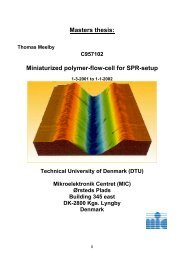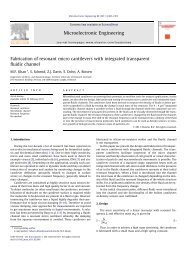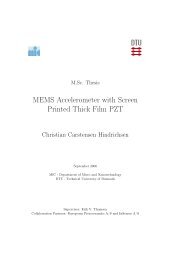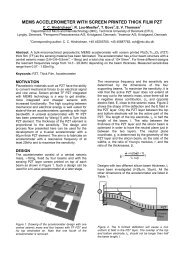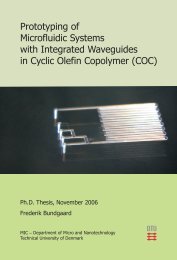C - DTU Nanotech - Danmarks Tekniske Universitet
C - DTU Nanotech - Danmarks Tekniske Universitet
C - DTU Nanotech - Danmarks Tekniske Universitet
Create successful ePaper yourself
Turn your PDF publications into a flip-book with our unique Google optimized e-Paper software.
Freezing time [s]<br />
50<br />
45<br />
40<br />
35<br />
30<br />
25<br />
20<br />
15<br />
10<br />
5<br />
0<br />
5.2 Results and discussion 39<br />
PBS-buffer LB-medium<br />
0 5 10 15 20 25<br />
Volume [µl]<br />
Figure 5.7: Averages of the freezing times against the different volumes of PBS–buffer and<br />
LB–medium. The standard deviation is shown<br />
Appendix). Due to this result, it can be concluded that in the former experiments pipettes<br />
were used whose calibration was incorrect. The absolute values of the freezing times were<br />
different, because of the different parameters of PBS–buffer and LB–medium, for example<br />
the salt concentration. Therefore, it can be assumed that the freezing time decreased linear<br />
with the sample volume.<br />
Experiments with PBS–buffer relating to the temperature over time<br />
The temperature in a PBS–drop was measured during freezing and the experiment was<br />
repeated three times. As expected the resulting curves had a plateau during the phase tran-<br />
sition. The curve of the first and the third experiment were very much the same, except for<br />
the end temperature: in the first experiment the temperature was −10.9 ◦ C, in the third ex-<br />
periment −9.1 ◦ C after 4 min. In the second experiment, the temperature in the PBS–buffer<br />
drop reached the 0 ◦ C 30 s later as in the other two experiments. The end temperature was<br />
−9.2 ◦ C (Fig. 5.9, data are shown in the Appendix). The absolute temperatures were not<br />
so important, due to the hole in the top cover a negative heat transfer occurred and the<br />
metal temperature sensor was also conducting heat out of the system. So the experiments<br />
showed that the Peltier element was working stable but not 100 % reproducible. A minimal<br />
temperature of −11.4 ◦ C was measured after 10 min of freezing.<br />
Verifying the thermometer accuracy, the results showed a difference of about 1 ◦ C between<br />
the two mercurial thermometers and the VOLTCRAFT temperature sensor. Most probably<br />
the values from the sensor were about 1 ◦ C too high.



